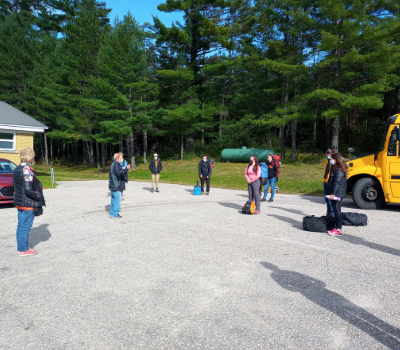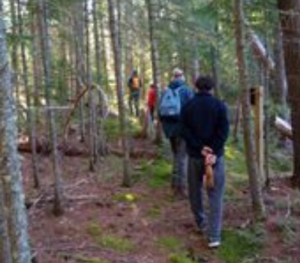Rapids, Historic Trails, and Stewardship – This Year’s CWSP Trip
What is the CWSP?
The goal of the CWSP (Canadian Wilderness Stewardship Program) is to connect local youth to nature and conservation, to introduce them to iconic landscapes in our region, and to teach them how organizations like ours secure protection for lands and water. Youth aged 18 to 30 who are interested in nature conservation and passionate about making a difference in their region were asked to apply earlier in the year. COVID-19 safety protocols were in place for the entirety of the trip, with the proper physical distancing, mask wearing, and sanitization measures.
This year’s stewardship trip:
This year was our second annual trip, and took place in the ZEC Dumoine (Zones d’Exploitation Contrôlée) from September 18 to 20. The Dumoine River is one of the rivers CPAWS is actively working to protect, approximately 140 km in length and a renowned wilderness paddling destination, it flows from North to South towards the Ottawa River. The Dumoine is located in the heart of the biologically diverse Laurentian mixed forest, creating a natural boundary between the Pontiac and Témiscamingue Regional County Municipality.

The Dumoine is unique for many reasons, including being one of the last undammed rivers in southern Québec, and having the largest area of unfragmented southern boreal forest in the province. It is a continentally significant wildlife corridor, protecting a critical link from La Vérendrye Wildlife Reserve to Algonquin Park, and is a historic watershed for both Algonquin communities and French settlers.

We arrived with the youth in Rapides-des-Joachims, Québec on Friday the 18th, where we were welcomed by Mayor Jim Gibson and his wife, Tina. Jim and Tina spoke passionately to the youth about their community, sharing historically significant events like the log drive, as well as fun activities to do while visiting (the Dumoine is a great river for fishing!). From the Town Hall, we boarded a shuttle for our 1.5-hour journey to the Dumoine Club lodge about 45 km to the North. Once there, we set up our tents and had dinner before enjoying a campfire by the river’s edge.
We were lucky to have a clear and sunny Saturday when we met with our outfitter and river guide Jim Coffey of Esprit Rafting, who gave us some pointers on how to safely navigate the river before the group headed off. We spent most of the day canoeing on the Dumoine, facing two sets of rapids, enjoying stunning scenery, and paddling approximately 14 km before camping for the night at Robinson Lake. The youth were incredibly engaged and posed some fantastic questions while we sat by the fire. We would like to give a huge thank you to Jim for leaving the youth so inspired by his thoughtful conversations and encouragements.

Chloé, our Education Director, led a guided nature walk on Sunday morning, leading the group down a trail that runs alongside the Dumoine, teaching the youth about the plants and trees that are common in the region. Following that, we hiked along the historic and powerful Grande Chute – the trail in that area is thousands of years old, having been used by Indigenous Peoples for generations, and then again by fur traders, loggers and, more recently, recreationalists.
We came back to camp for lunch in the afternoon, then the youth  helped us construct a simple bridge over a small stream on a section of trail adopted and restored by CPAWS. The materials were pre-cut, but they had to figure out how to put it together, and they worked together wonderfully. We debriefed at the end of the day before boarding a shuttle back to town, wrapping up the trip.
helped us construct a simple bridge over a small stream on a section of trail adopted and restored by CPAWS. The materials were pre-cut, but they had to figure out how to put it together, and they worked together wonderfully. We debriefed at the end of the day before boarding a shuttle back to town, wrapping up the trip.
What happens now?
Back at home, the youth are now thinking about their community service projects and are taking part in a series of webinars organized by Chloé to get new skills to help them develop and implement their ideas. They are all devoting at least 120 hours to their service projects over the next six months, and we are ready to support them in their journeys.
We hope to bring the CWSP youth together from all four participating CPAWS chapters through a forum for sharing best practices, but given the current situation with the pandemic, we will have to monitor what is possible going forward. In the meantime, CPAWS-OV is excited to share any future updates on our participants’ projects, so be sure to check back regularly on our social media channels for exciting updates on their projects.

